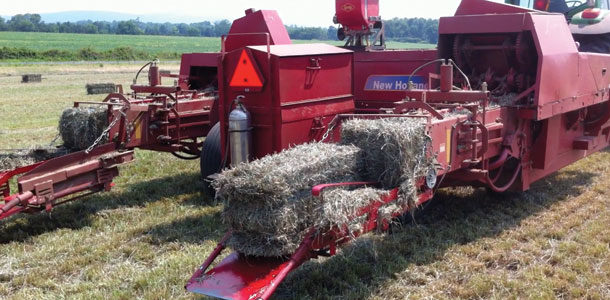This alone more than doubles efficiency, and with fewer turns needed in the field by this single unit, accompanied by its increased plunger stroke count per minute, Inskeep has proven it can bale more pounds of hay per hour than three individual balers can.
The “Mt. Pony Special” is capable of baling 5,000 bales per day, or 900 60-pound bales per hour in heavy first-cutting hay. In Culpeper County, Virginia, hay can be baled around noon and must cease with dewfall by early evening.
The Inskeeps have counted output from the baler at 140,000 bales over two seasons or about 70,000 bales of hay and straw per year.
The idea was to assemble two balers together to operate as one unit, joining them in the middle at the pickup head. One of the balers was left mostly intact as it came from the factory – other than being joined with the other baler.
But the second baler needed significant modifications to allow it to work as a unit with the first baler. It was cut apart and reassembled conjoined at the pickup head and by the custom hitch to allow the unit to operate. It spits out two rows of small square bales.
This is a story of two generations of thinking and doing, two generations of smarts, hard work and inventive uses of technology and skill coming together in a modern-day improvement to small square hay-baling efficiency.

Paul Inskeep joins his uncle Rusty as a fourth-generation operator at Mt. Pony Farms; his brothers and cousins also have and do participate in the operation.
As is the case on most farms, it comes naturally and is often a requirement of the occupation to engineer, design, modify and build better equipment.
The Mt. Pony Farm shop is always busy with a project or two under construction, supervised by three primary operators – brothers Rusty, Bill and John. They constantly strive to improve efficiency, timing and reduce costs.
Over two winters working together, Rusty and Paul (Bill’s son) managed to design and build an amazing machine they call the “double-barrel” baler, later christened the “Mt. Pony Special.”
The younger generation stepped up as the hitch was being designed and assembled. Paul brought his skills with computer programming to engineer and assess design strength, materials tolerance and stress points which allowed many “iterations” to be run on paper to avoid making more permanent mistakes in the long run.
The hitch is a critical element of the entire machine. It must carry and distribute the load, while arching over a huge windrow of hay being force-fed into the 7-foot 4.5-inch pickup head (standard width 6 feet).
The complex and heavy, arching hitch is connected to a 140 hp tractor running dual wheels for stability. The baler is 13 feet wide and weighs 11,000 pounds with a tongue weight of 2,640 pounds.
The 1,000 rpm drive shaft turned by the tractor reduces down to 540 rpms after passing through right-angle gear boxes, turning the power through standard flywheels and into the dual chambers cutting and compressing hay into bales.
The unit has scales to allow for adjustment in bale size and density needed by the three self-propelled bale wagons which pick up the hay.
Moisture testing is on-the-go and twine is dispensed from a custom 16-ball twine box. Two super single-trailer tires (24 ply) keep the heavy machine on a straight track during operation and carry the bulk of the machine’s weight.
Mt. Pony Farms Inc. is a 2,000-acre crop and hay farm located in Culpeper County, Virginia. Brothers Rusty, Bill and John Inskeep work as a team and specialize in their own areas of expertise.
Timing is everything at Mt. Pony Farms, and they excel at efficiency. This baler follows a long list of other innovations supportive of the principles they live by. FG
PHOTOS
PHOTO 1: The “Mt. Pony Special” features a double-barrel baler designed with the creativity and experience of one farm generation coupled with the technology and engineering of another farm generation to create a high-volume-output square baler.
PHOTOS 2: Paul and Rusty Inskeep don’t see problems – only challenges, as they combine talents to modify equipment to suit their needs.
Photos courtesy of Carl Stafford.
Carl C. Stafford
Extension Agent, ANR Animal Science
Virginia Tech









